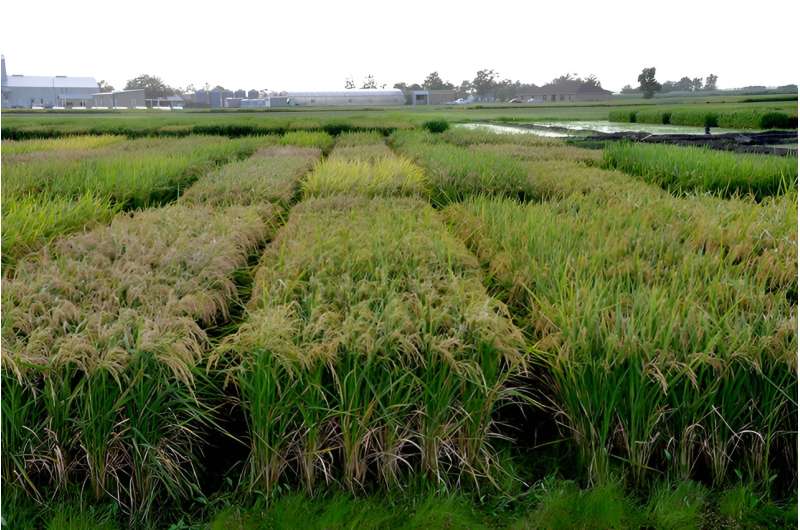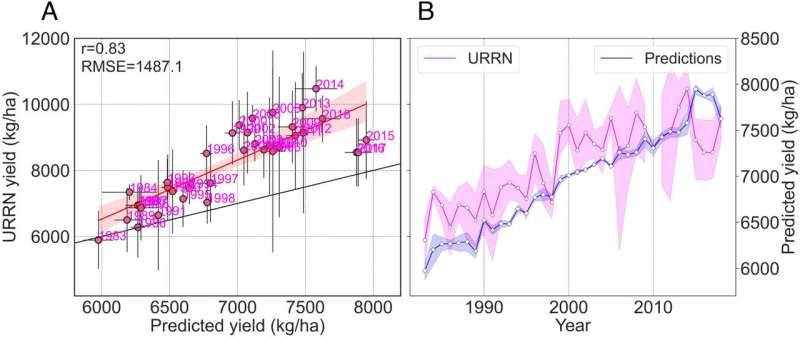This article has been reviewed according to Science X's editorial process and policies. Editors have highlighted the following attributes while ensuring the content's credibility:
fact-checked
peer-reviewed publication
trusted source
proofread
Machine learning model demonstrates effect of public breeding on rice yields in climate change

Climate change, extreme weather events, unprecedented records in temperatures, and higher, acidic oceans make it difficult to predict the long-term fate of modern crop varieties.
In a paper published in the Proceedings of the National Academy of Sciences, Diane Wang, an assistant professor in Purdue's Department of Agronomy, and her post-doctoral researcher Sajad Jamshidi, reported on a predictive model they've developed that uses machine learning algorithms to predict how rice yields will be affected by climate change.
Their work was completed in collaboration with researchers at Cornell University and the Dale Bumpers National Rice Research Center.
"With these kinds of large-scale statistical models, you're basically taking a set of predictors—like weather or genetics—and mapping them to solve for an outcome. Here, we are interested in predicting yield," Wang said.
The U.S. is in the top five exporters of rice, making rice production across several southern states important to diets around the world. Wang and Jamshidi's work lays a foundation for artificial intelligence predictions in rice and other crops, potentially helping agriculture hone breeding practices where crop varieties are most vulnerable to climate change.
Through this model, the team found that modern varieties of rice are likely to do "less badly" than older varieties in a future impacted by climate change. Public breeding programs, like those based at universities, are largely behind the success of present-day rice.
Their development of new varieties has broadened the gene pool for U.S. rice while also incorporating specific, targeted traits. Wang said this study underscores the importance of the historic and ongoing contributions of these public breeding programs.

"The ensemble model predicts that modern groups of rice varieties will do less badly than groups of older varieties, but I would be careful to say we've finished our job," Wang said. "There is a lot of uncertainty with respect to future climates, and these kinds of models are just one tool to explore scenarios."
Rice has a small genome compared with other crops. That and the availability of historical data and old-variety seeds made it the ideal study system for designing a predictive model. The team obtained historical temperatures and weather data as well as what Wang called the "serendipitous discovery of variety acreage reports."
Since the 1970s, the southern U.S. rice-growing states of the Mississippi Delta region have recorded what variety of rice was grown in what proportion at the county level. Many of these acreage reports were sent to the team as typewritten documents. The group then obtained seeds from old rice varieties that are no longer commonly grown from collaborators at the Dale Bumpers National Rice Research Center.
These rice varieties were analyzed at the genetic level, and Wang and collaborators grouped varieties based on alleles, or gene variations, that they shared. They translated this information from the variety of acreage reports into county-level "bags of alleles" and then trained machine learning models using the allele groups and county-level yields with historical environmental data, like temperature and precipitation.
Jamshidi's efforts in building this model are especially novel because the final model combines 10 methods of machine learning to create an ensemble model that can process information with a more multifaceted approach. The ensemble model's output offers more accurate results under the same predictors.
Not only will this study provide a framework to build models for other crops with similar predictors, but Wang sees another possible direction for this research. Carrying out physical experiments by growing both old and modern rice varieties under predicted conditions could serve as an additional evaluation of the model, as well as give hints to the genetic and physiological makeup causing the difference in resilience between the variety groups.
Wang said, "These kinds of predictions are really the first step. The model has given us some potential outcomes, but now someone has to run the follow-up experiments to get at underlying mechanisms."
Wang and her lab continue to study the interactions between crops' genetics and their environment, and they are using modeling and other technologies to create a more predictable future for agriculture.
More information: Diane R. Wang et al, Positive effects of public breeding on US rice yields under future climate scenarios, Proceedings of the National Academy of Sciences (2024). DOI: 10.1073/pnas.2309969121
Journal information: Proceedings of the National Academy of Sciences
Provided by Purdue University





















